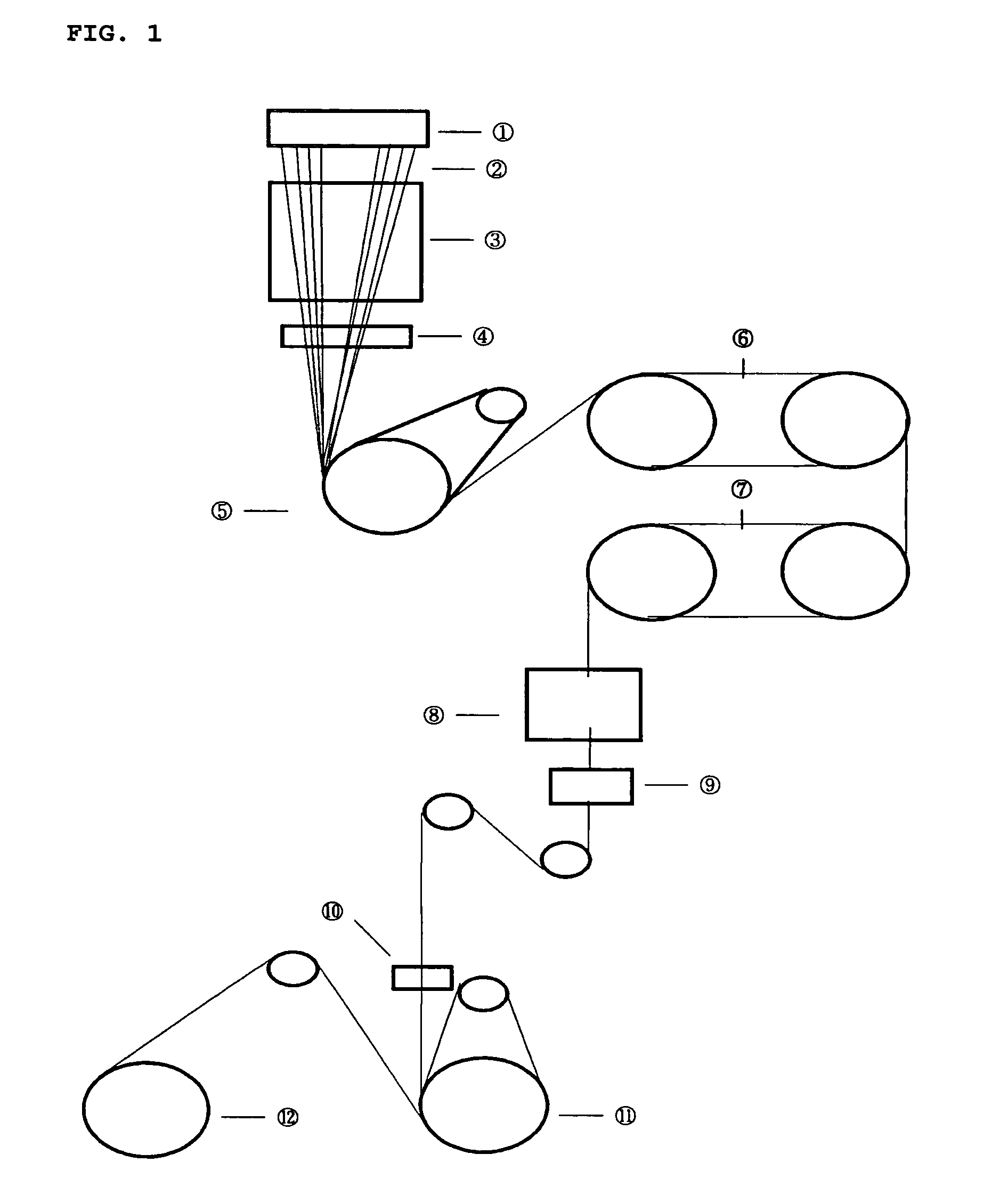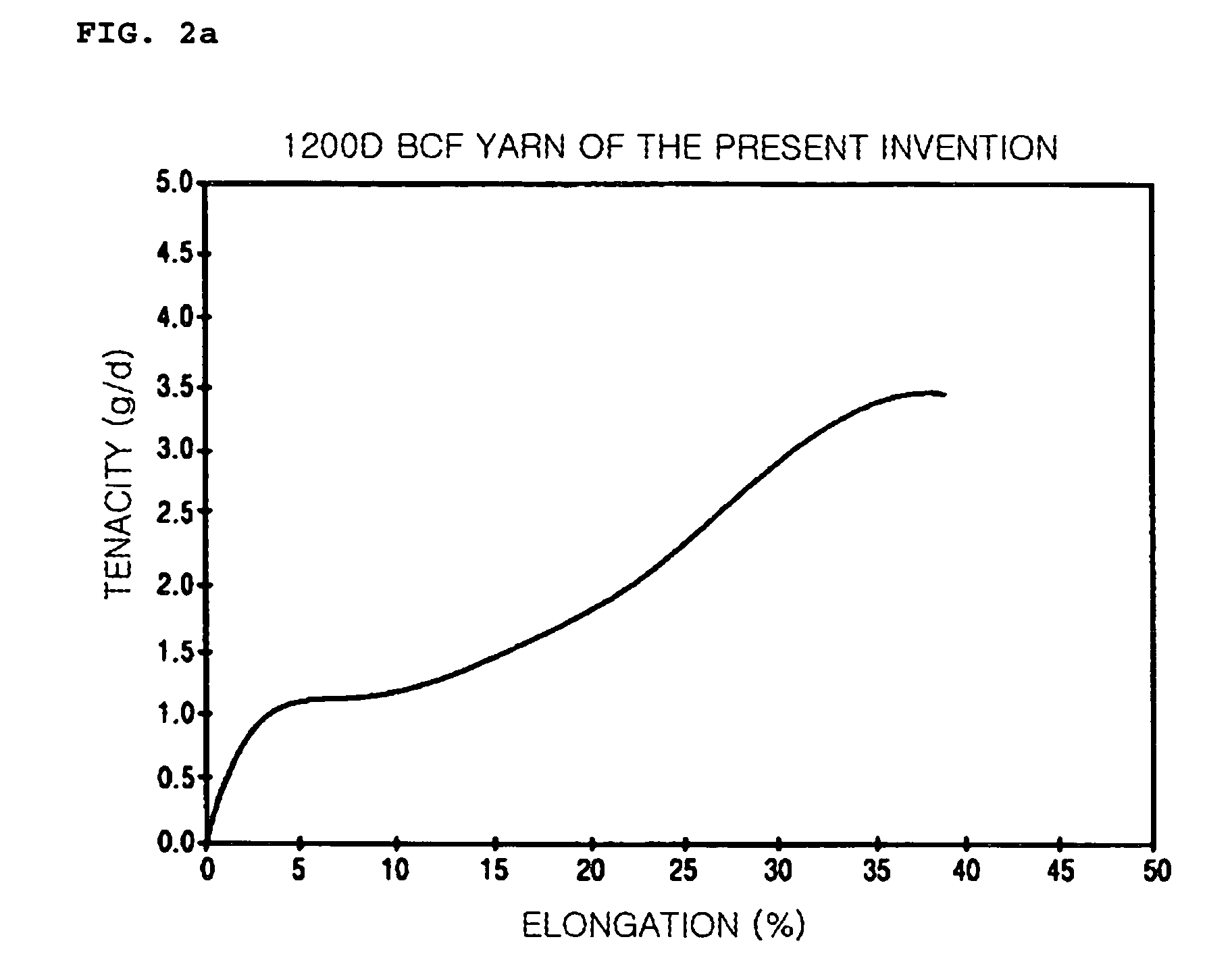3-Dimension crimp polyethylene terephthalate multifilament for carpet
a polyethylene terephthalate and multi-filament technology, applied in the direction of synthetic resin layered products, yarn, transportation and packaging, etc., can solve the problems of poor durability of fibers, deterioration of lightfastness, discoloration of polymers, etc., to improve flame retardancy and toughness of polyethylene terephthalate, high flame retardancy and toughness
- Summary
- Abstract
- Description
- Claims
- Application Information
AI Technical Summary
Benefits of technology
Problems solved by technology
Method used
Image
Examples
example 1
[0053]Slurry that was prepared using 8650 g of terephthalic acid (TPA) and 2700 g of ethylene glycol (EG) was subjected to esterification using a semibatch process. The temperature of an esterification reactor was maintained at 250 to 260° C. Produced oligomers were transferred to a polycondensation reactor. A solution in which 65 wt % substance of Formula (1) where n is 1 and R1 and R2 are CH2CH2OH was dissolved in EG was used as a flame retardant. After 1580 g of flame-retardant solution was added, manganese acetate and phosphoric acid were added as UV stabilizers in amounts of 50 ppm and 45 ppm based on manganese and phosphorus atoms. 200 g of a 2 wt % solution of antimony trioxide in EG was added as a catalyst to conduct polycondensation, thereby a polymer having an intrinsic viscosity (IV) of 0.65 dl / g is obtained
[0054]The polyethylene terephthalate polymer having the intrinsic viscosity (IV) of 0.65 and a moisture content of 120 ppm was melt spun through a spinneret having 68 ...
example 2
[0055]The spinning was conducted using the same polymer as Example 1, but the rates of the supplying roller, the drawing rollers, and the relaxing roller were set to be different from those of Example 1 to produce a flame-retardant PET BCF having denier, strength, and the elongation that were different from those of Example 1.
[0056]After the polymer was subjected to a spin finish step, the polymer passed through the supplying roller at 95° C. at a rate of 532 m / min, and was then drawn at a rate of 2820 m / min using the drawing rollers. The temperature of the drawing rollers was 160° C. The grey yarn that passed through the drawing rollers passed through a texturing nozzle to have crimp. In this, the temperature of steam was 208° C., the pressure was 4.8 kg / cm2, and the back pressure was 2.5 kg / cm2. Subsequently, cooling was conducted using cooling water, and interlacing was conducted at pressure of 4.0 kg / m2 in a ratio of 16 times / m in a collector. The yarn passed through the relaxin...
example 3
[0057]The spinning was conducted under the same conditions as Example 1 to produce a dope dyed yarn except that 3 wt % of a color masterbatch was added based on the amount of base chips added in the course of feeding raw materials so as to conduct blending spinning.
PUM
| Property | Measurement | Unit |
|---|---|---|
| temperature | aaaaa | aaaaa |
| speed | aaaaa | aaaaa |
| temperature | aaaaa | aaaaa |
Abstract
Description
Claims
Application Information
 Login to View More
Login to View More - R&D
- Intellectual Property
- Life Sciences
- Materials
- Tech Scout
- Unparalleled Data Quality
- Higher Quality Content
- 60% Fewer Hallucinations
Browse by: Latest US Patents, China's latest patents, Technical Efficacy Thesaurus, Application Domain, Technology Topic, Popular Technical Reports.
© 2025 PatSnap. All rights reserved.Legal|Privacy policy|Modern Slavery Act Transparency Statement|Sitemap|About US| Contact US: help@patsnap.com



